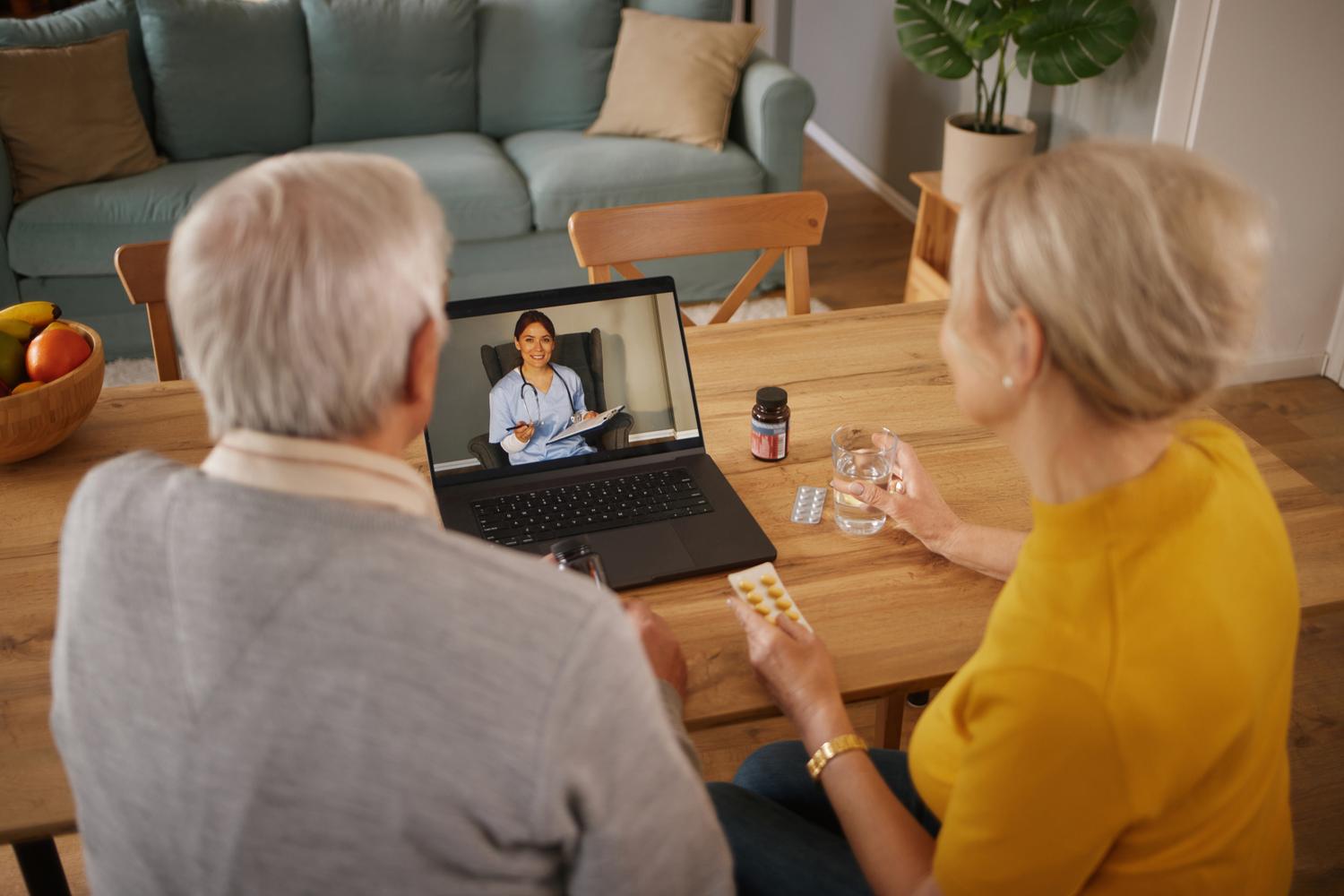Telehealth Vs In-Person Care: Which Is Right For You?
How to determine the best care option for your medical needs
If you’ve tried telehealth for the first time over the past several years, you’re not alone! When the COVID-19 pandemic began in 2020, there was a large shift in patients from in-person care to telehealth due to over-crowded hospitals, lack of in-person provider availability and fears about the spread of coronavirus in waiting rooms. Since then, telehealth has skyrocketed in popularity amongst providers and patients, with research showing that telehealth usage levels are 38x higher now than they were pre-pandemic.
However, it can be difficult to know which appointment is best suited for your type of care needs. In this comparison, we’ll discuss the pros and cons of both in-person and virtual appointments so that you can decide which care type is right for you.
What is in-person care?
In-person medical care refers to the traditional, face-to-face interaction between healthcare providers and patients within a clinical setting, such as a doctor’s office, urgent care facility or hospital. This form of patient care typically involves a physical examination, diagnosis and treatment administered by physicians, nurses or other healthcare professionals.
What are the advantages of in-person care?
In-person medical care offers several key advantages that contribute to its importance in the healthcare field:
- Physical touch: In-person visits allow healthcare providers to conduct a thorough physical examination. Face-to-face visits also allow healthcare providers to pick up on non-verbal cues, such as body language, which can provide valuable information about a patient's condition and emotional state.
- Immediate intervention: In-person care allows for prompt diagnosis and treatment, which is particularly important in emergencies or when dealing with complex medical conditions.
- Access to on-site resources: Patients benefit from immediate access to medical equipment, laboratory tests and additional healthcare professionals within the clinical setting. This makes in-person care an ideal setting for medical needs such as vaccinations, blood draws and other medical procedures which can’t be performed virtually.
What are the disadvantages of in-person care?
Even though in-person care is undoubtedly a critical part of the healthcare system, it also has its cons. Some pitfalls of in-person care include:
- Limited accessibility: In-person medical care may be difficult to access for those living in remote or rural areas, or for individuals with mobility issues or transportation limitations.
- Inconvenience: In-person wait times have increased exponentially in the past few years due to backlogs of patients who delayed medical care during the pandemic. Patients often need to schedule appointments well in advance, and may spend considerable time waiting in the clinic or hospital.
- Potential exposure to infections: Visiting healthcare facilities can increase the risk of exposure to contagious illnesses, especially for immunocompromised individuals. According to the CDC, an estimated 648,000 people in the U.S. develop infections during a hospital stay.
- Higher costs: In-person consultations can be more expensive than remote care options due to overhead costs associated with maintaining a physical location and additional staffing requirements. Providers also often charge more for in-person appointments because they need to cover third-party fees from insurance companies and paperwork processing vendors.
What is telehealth?
Telehealth is a modern approach to healthcare that leverages technology to provide remote medical services to patients, enabling them to access care without physically visiting a healthcare facility. Through various telecommunication platforms such as video conferencing, telephone calls, or secure messaging applications, patients can consult with physicians, nurses, or other healthcare professionals from the comfort of their own homes. Telehealth has gained significant traction in recent years, particularly during times of social distancing or when in-person care may not be feasible.
What are the advantages of telehealth?
The rise in popularity of telehealth over the past few years has highlighted some key benefits, including:
- Increased accessibility: No vehicle? No nearby hospitals? No problem. Because it can be accessed via phone call, messaging or video conferencing, telehealth makes medical care more readily available to individuals in remote or rural areas, as well as those with mobility issues or transportation limitations.
- Time and cost savings: Patients can save time and money by eliminating the need for travel and reducing time spent waiting for appointments. Telehealth is also proven to be a much more affordable option - a study from the American Journal of Managed Care found that in 2022, telehealth appointments typically cost around $40 to $50, while in-person care averaged out to about $176 per visit!
- Convenience and comfort: Patients can consult with healthcare providers from the comfort of their own homes, potentially reducing anxiety or discomfort associated with clinical settings. As mentioned above, remote consultations can also minimize the risk of exposure to contagious illnesses in healthcare facilities.
- Expanded provider options: Telehealth enables patients to access a wider range of healthcare professionals, regardless of their geographic location. For patients seeking a provider who is proficient in a certain language or who specializes in a certain condition, telehealth can be a game changer.
- Reduced strain on healthcare facilities: By addressing non-emergency issues remotely, telehealth can help alleviate overcrowding and resource constraints in hospitals and clinics.
What are the disadvantages of telehealth?
Despite its benefits, telehealth does have limitations. Disadvantages of virtual care include:
- Limitation to non-emergency situations: Virtual visits cannot replace in-person emergency care, which requires immediate physical and tactile evaluation.
- Technical issues: Connectivity problems, poor audio or video quality, and software issues can hinder effective communication between patients and healthcare providers. Patients without access to reliable internet or appropriate devices may face difficulties accessing telehealth services, exacerbating existing health disparities.
- Health plan coverage inconsistencies: Insufficient or inconsistent health insurance coverage for telehealth services can be a barrier to widespread adoption and sustainability. However, there are virtual healthcare services available that don’t require health insurance - including Sesame! Simply browse prices for providers and pay up-front for the care you need without dealing with co-pays, deductibles and surprise bills from your insurance company.
What's the better option, telehealth or in-person care?
The bottom line is that both care types have their pros and cons, and the best way to determine what type of care is right for you is to assess your own needs. In-person medical care remains a vital component of healthcare systems, as it allows for more hands-on attention to patients' needs. If you’re experiencing an issue that requires an in-person procedure such as vaccination, a physical exam or a blood draw, then an office visit is likely the best option.
While telehealth is not suitable for emergency situations and medical procedures, it can be used for management of chronic diseases like diabetes and obesity, or acute conditions such as UTIs, yeast infections or the flu. It can also be leveraged for an array of other care needs, such as prescription refills, vision exams, dermatological concerns, mental health consults and postoperative follow-ups. In fact, recent research on the use of telemedicine for post-operative care have demonstrated extremely high levels of patient and provider satisfaction - in a study on post-operative telehealth care, providers reported patient satisfaction of 97% with telemedicine, as opposed to 86% with traditional office follow-up.
Telemedicine visits also offer an array of benefits, including increased accessibility for individuals in remote locations and reduced healthcare costs. The reality is that in-person care and telehealth serve as valuable complements to each other by expanding the reach and efficiency of healthcare systems. If you’re still not sure what kind of care is best for you, you can browse Sesame for telehealth appointments that align with your medical care needs ( including clinician appointments for prescriptions, primary care, labs, high blood pressure and more) so that you can get the care you need - at half the price.
Related posts

In this article, we’ll take a look at some of the most crucial advantages of teledentistry and how this exciting new platform can save you time and money.

Teledentistry services et patients connect with dentists nationwide to discuss oral health conditions and treatment plans.

Discover the benefits of online urgent care, from diagnosing common ailments like asthma and UTIs to reducing healthcare costs and system strain. Virtual visits offer a convenient, cost-effective solution, enhancing accessibility for many patients.

Discover the top 7 therapist directories of 2023, including their pros, cons, and costs. Learn how these platforms can help you increase visibility, attract clients, and grow your practice effectively.

As the PHE comes to an end on May 11, the DEA is proposing new restrictions (or restoring previous restrictions) on the prescription of certain controlled substances - including some anxiety medications, painkillers, ADHD medications and more.

It can be difficult to figure out the best treatment plan for your health. We’ve compared the cost of asthma inhalers and detailed the pros and cons of each.

On Oct 1, millions of seniors lost their Medicare telehealth coverage. Here’s why, what’s next, and where to find low-cost virtual care without insurance.

Direct-to-consumer (DTC) telemedicine, sometimes called “direct-to-patient” care or “on-demand” care, is a type of telemedicine where patients have instant access to healthcare providers or services.

The impact of so much screen time on children creates ripple effects that span both physical and emotional domains. Physically, the strain of watching a screen for many hours can tire a child's eyes.
